现在分词与过去分词作状语的区别
- 格式:ppt
- 大小:1.58 MB
- 文档页数:15


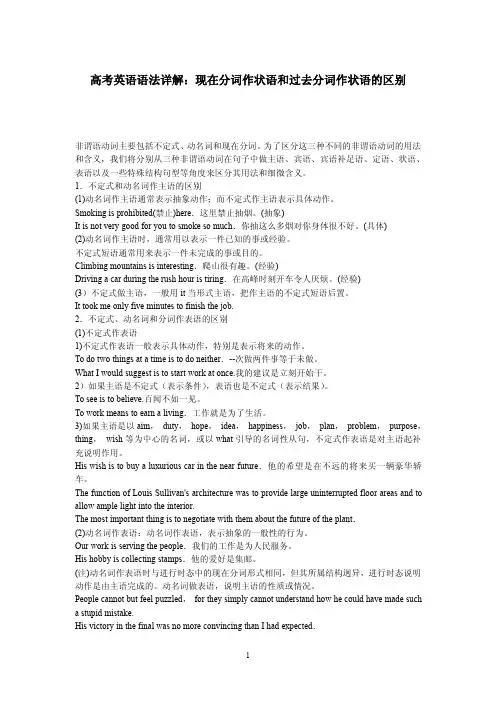
高考英语语法详解:现在分词作状语和过去分词作状语的区别非谓语动词主要包括不定式、动名词和现在分词。
为了区分这三种不同的非谓语动词的用法和含义,我们将分别从三种非谓语动词在句子中做主语、宾语、宾语补足语、定语、状语、表语以及一些特殊结构句型等角度来区分其用法和细微含义。
1.不定式和动名词作主语的区别(1)动名词作主语通常表示抽象动作;而不定式作主语表示具体动作。
Smoking is prohibited(禁止)here.这里禁止抽烟。
(抽象)It is not very good for you to smoke so much.你抽这么多烟对你身体很不好。
(具体)(2)动名词作主语时,通常用以表示一件已知的事或经验。
不定式短语通常用来表示一件未完成的事或目的。
Climbing mountains is interesting.爬山很有趣。
(经验)Driving a car during the rush hour is tiring.在高峰时刻开车令人厌烦。
(经验)(3)不定式做主语,一般用it当形式主语,把作主语的不定式短语后置。
It took me only five minutes to finish the job.2.不定式、动名词和分词作表语的区别(1)不定式作表语1)不定式作表语一般表示具体动作,特别是表示将来的动作。
To do two things at a time is to do neither.--次做两件事等于未做。
What I would suggest is to start work at once.我的建议是立刻开始干。
2)如果主语是不定式(表示条件),表语也是不定式(表示结果)。
To see is to believe.百闻不如一见。
To work means to earn a living.工作就是为了生活。
3)如果主语是以aim,duty,hope,idea,happiness,job,plan,problem,purpose,thing,wish等为中心的名词,或以what引导的名词性从句,不定式作表语是对主语起补充说明作用。
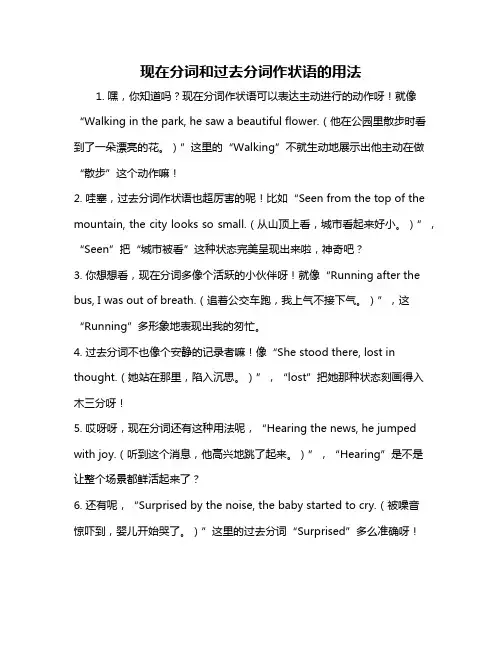
现在分词和过去分词作状语的用法
1. 嘿,你知道吗?现在分词作状语可以表达主动进行的动作呀!就像“Walking in the park, he saw a beautiful flower.(他在公园里散步时看到了一朵漂亮的花。
)”这里的“Walking”不就生动地展示出他主动在做“散步”这个动作嘛!
2. 哇塞,过去分词作状语也超厉害的呢!比如“Seen from the top of the mountain, the city looks so small.(从山顶上看,城市看起来好小。
)”,“Seen”把“城市被看”这种状态完美呈现出来啦,神奇吧?
3. 你想想看,现在分词多像个活跃的小伙伴呀!就像“Running after the bus, I was out of breath.(追着公交车跑,我上气不接下气。
)”,这“Running”多形象地表现出我的匆忙。
4. 过去分词不也像个安静的记录者嘛!像“She stood there, lost in thought.(她站在那里,陷入沉思。
)”,“lost”把她那种状态刻画得入木三分呀!
5. 哎呀呀,现在分词还有这种用法呢,“Hearing the news, he jumped with joy.(听到这个消息,他高兴地跳了起来。
)”,“Hearing”是不是让整个场景都鲜活起来了?
6. 还有呢,“Surprised by the noise, the baby started to cry.(被噪音
惊吓到,婴儿开始哭了。
)”这里的过去分词“Surprised”多么准确呀!
所以说呀,现在分词和过去分词作状语真的太有用啦,大家一定要学会好好利用呀!。

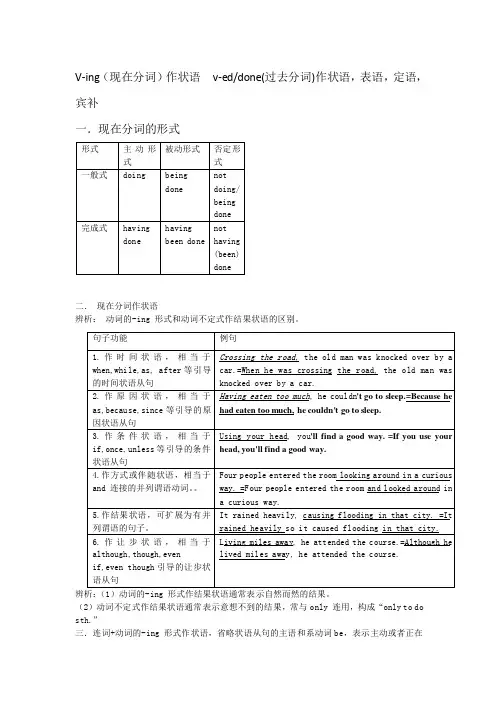
V-ing (现在分词)作状语v-ed/done(过去分词)作状语,表语,定语,宾补一.现在分词的形式形式主动形式被动形式否定形式一般式doing beingdone not doing/beingdone完成式havingdone having been done not having(been)done二.现在分词作状语辨析:动词的-ing 形式和动词不定式作结果状语的区别。
辨析:(1)动词的-ing 形式作结果状语通常表示自然而然的结果。
(2)动词不定式作结果状语通常表示意想不到的结果,常与only 连用,构成“only to do sth.”三.连词+动词的-ing 形式作状语,省略状语从句的主语和系动词be ,表示主动或者正在句子功能例句1.作时间状语,相当于when,while,as,after 等引导的时间状语从句Crossing the road,the old man was knocked over by a car.=When he was crossing the road,the old man was knocked over by a car.2.作原因状语,相当于as,because,since 等引导的原因状语从句Having eaten too much ,he couldn 't go to sleep.=Because he had eaten too much,he couldn't go to sleep.3.作条件状语,相当于if,once,unless 等引导的条件状语从句Using your head,you 'll find a good way.=If you use your head,you'll find a good way.4.作方式或伴随状语,相当于and 连接的并列谓语动词。
Four people entered the room looking around in a curious way.=Four people entered the room and looked around in a curious way.5.作结果状语,可扩展为有并列谓语的句子。

现在分词和过去分词的用法现在分词和过去分词主要差别在于:现在分词表示“主动和进行”,过去分词表示“被动和完成”(不及物动词的过去分词不表示被动,只表示完成)。
分词可以有自己的状语、宾语或逻辑主语等。
表示伴随 1. 分词作状语分词在句子中作状语,可以表示时间、条件、原因现在分词和过去分词主要差别在于:现在分词表示“主动和进行”,过去分词表示“被动和完成”(不及物动词的过去分词不表示被动,只表示完成)。
分词可以有自己的状语、宾语或逻辑主语等。
表示伴随1. 分词作状语分词在句子中作状语,可以表示时间、条件、原因、结果(补充说明)、让步、伴随等。
分词做状语时,它的逻辑主语与句子的主语一致。
作状语的分词相当于一个状语从句。
补充说明补充说明【例】Hearing the news, they all jumped with joy.Using what you know of word stems and word formations, you can make a guess at the meaning of a new word.The students went out of the classroom, laughing and talking.Accompanied by his friend, he went to the railway station. Given better attention, the plants could grow better.He looked tired and depressed, visibly disturbed by the news of his mother's illness.分词在句子中作状语,使用何种分词,要取决于分词与句子主语的关系:主谓关系用现在分词,动宾或被动关系用过去分词。
【例】Not shavings enough hands, we turned to them for help.(we don't have enough hands) Taught by mistakes and setbacks, we have become wiser and handled our affairs better. (we are taught/teach us)Inspired by Leifeng, the people in China worked very hard to achieve their modernization.____the earth to be flat, many feared that Columbus would fall off the edge. (CET-4 1996,6)A) Having believed B) Believing C) Believed D) Being believed本句意思为:相信地球是平的,许多人担心哥伦布会从边上掉下去。
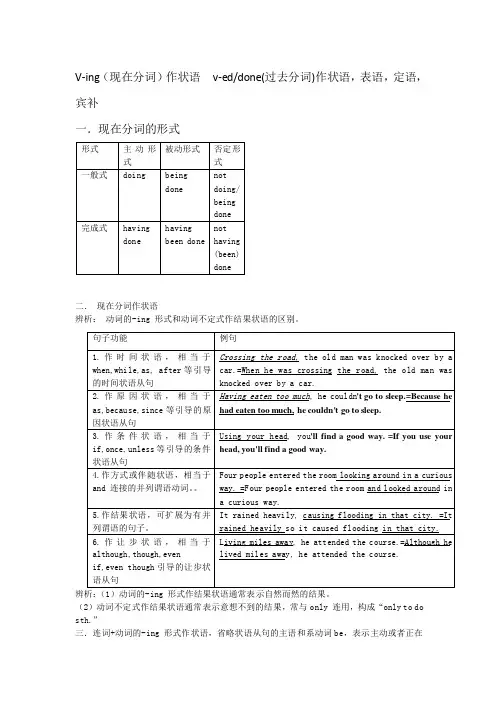
V-ing (现在分词)作状语v-ed/done(过去分词)作状语,表语,定语,宾补一.现在分词的形式形式主动形式被动形式否定形式一般式doing beingdone not doing/beingdone完成式havingdone having been done not having(been)done二.现在分词作状语辨析:动词的-ing 形式和动词不定式作结果状语的区别。
辨析:(1)动词的-ing 形式作结果状语通常表示自然而然的结果。
(2)动词不定式作结果状语通常表示意想不到的结果,常与only 连用,构成“only to do sth.”三.连词+动词的-ing 形式作状语,省略状语从句的主语和系动词be ,表示主动或者正在句子功能例句1.作时间状语,相当于when,while,as,after 等引导的时间状语从句Crossing the road,the old man was knocked over by a car.=When he was crossing the road,the old man was knocked over by a car.2.作原因状语,相当于as,because,since 等引导的原因状语从句Having eaten too much ,he couldn 't go to sleep.=Because he had eaten too much,he couldn't go to sleep.3.作条件状语,相当于if,once,unless 等引导的条件状语从句Using your head,you 'll find a good way.=If you use your head,you'll find a good way.4.作方式或伴随状语,相当于and 连接的并列谓语动词。
Four people entered the room looking around in a curious way.=Four people entered the room and looked around in a curious way.5.作结果状语,可扩展为有并列谓语的句子。
![[过去分词短语作状语]现在分词作状语和过去分词作状语的区别](https://uimg.taocdn.com/c258cfe82cc58bd63186bd5a.webp)
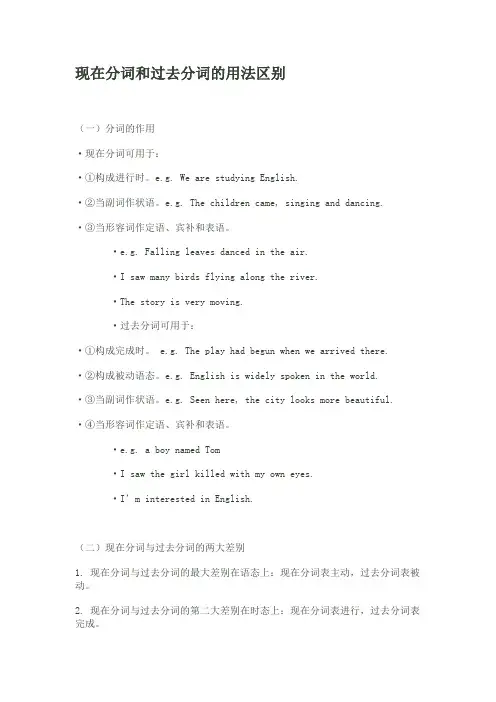
现在分词和过去分词的用法区别(一)分词的作用·现在分词可用于:·①构成进行时。
e.g. We are studying English.·②当副词作状语。
e.g. The children came, singing and dancing.·③当形容词作定语、宾补和表语。
·e.g. Falling leaves danced in the air.·I saw many birds flying along the river.·The story is very moving.·过去分词可用于:·①构成完成时。
e.g. The play had begun when we arrived there.·②构成被动语态。
e.g. English is widely spoken in the world.·③当副词作状语。
e.g. Seen here, the city looks more beautiful.·④当形容词作定语、宾补和表语。
·e.g. a boy named Tom·I saw the girl kille d with my own eyes.·I’m interested in English.(二)现在分词与过去分词的两大差别1. 现在分词与过去分词的最大差别在语态上:现在分词表主动,过去分词表被动。
2. 现在分词与过去分词的第二大差别在时态上:现在分词表进行,过去分词表完成。
3. 把握主、被动关系的两个前提1)弄清动词的确切含义。
不少主、被动关系判断错误都是由于没弄清动词的确切含义造成的。
Wrong: Girls frighten snakes.Right: Girls fear snakes./ Snakes frighten girls.牢记: tire, disappoint, satisfy, terrify, interest, frighten, worry, excite, surprise, please, seat, puzzle, ect. 只能作及物动词,都有“使动”的特点,都含“使……”之义。
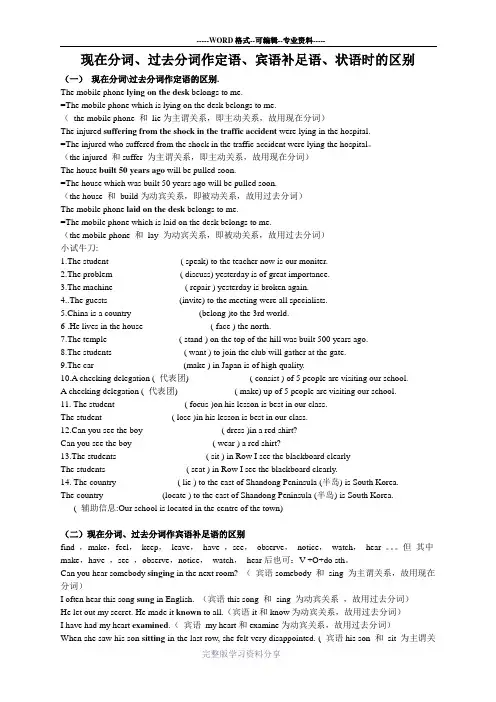
现在分词、过去分词作定语、宾语补足语、状语时的区别(一)现在分词\过去分词作定语的区别.The mobile phone lying on the desk belongs to me.=The mobile phone which is lying on the desk belongs to me.(the mobile phone 和lie为主谓关系,即主动关系,故用现在分词)The injured suffering from the shock in the traffic accident were lying in the hospital.=The injured who suffered from the shock in the traffic accident were lying the hospital。
(the injured 和suffer 为主谓关系,即主动关系,故用现在分词)The house built 50 years ago will be pulled soon.=The house which was built 50 years ago will be pulled soon.(the house 和build为动宾关系,即被动关系,故用过去分词)The mobile phone laid on the desk belongs to me.=The mobile phone which is laid on the desk belongs to me.(the mobile phone 和lay 为动宾关系,即被动关系,故用过去分词)小试牛刀:1.The student ________________( speak) to the teacher now is our moniter.2.The problem _______________( discuss) yesterday is of great importance.3.The machine ________________( repair ) yesterday is broken again.4..The guests ________________(invite) to the meeting were all specialists.5.China is a country _______________(belong )to the 3rd world.6 .He lives in the house _______________( face ) the north.7.The temple ________________( stand ) on the top of the hill was built 500 years ago.8.The students ________________( want ) to join the club will gather at the gate.9.The car ____________________(make ) in Japan is of high quality.10.A checking delegation ( 代表团)______________( consist ) of 5 people are visiting our school.A checking delegation ( 代表团)_____________( make) up of 5 people are visiting our school.11. The student________________( focus )on his lesson is best in our class.The student _______________ ( lose )in his lesson is best in our class.12.Can you see the boy _________________ ( dress )in a red shirt?Can you see the boy __________________( wear ) a red shirt?13.The students ____________________( sit ) in Row I see the blackboard clearlyThe students __________________( seat ) in Row I see the blackboard clearly.14. The country _____________ ( lie ) to the east of Shandong Peninsula (半岛) is South Korea.The country _____________(locate ) to the east of Shandong Peninsula (半岛) is South Korea.( 辅助信息:Our school is located in the centre of the town)(二)现在分词、过去分词作宾语补足语的区别find ,make,feel,keep,leave,have ,see,observe,notice,watch,hear 。
现在分词和过去分词的用法区别(一)分词的作用·现在分词可用于:·①构成进行时。
. We are studying English.·②当副词作状语。
. The children came, singing and dancing.·③当形容词作定语、宾补和表语。
·. Falling leaves danced in the air.·I saw many birds flying along the river.·The story is very moving.·过去分词可用于:·①构成完成时。
. The play had begun when we arrived there.·②构成被动语态。
. English is widely spoken in the world.·③当副词作状语。
. Seen here, the city looks more beautiful.·④当形容词作定语、宾补和表语。
·. a boy named Tom·I saw the girl killed with my own eyes.·I’m interested in English.(二)现在分词与过去分词的两大差别1.在语态上:现在分词表主动,过去分词表被动。
2.在时态上:现在分词表进行,过去分词表完成。
(三)确定分词的使用的具体步骤(1)根据句子结构确定分词的语法成分(2)找准逻辑主语(3)判断主、被动关系(4)选定现在或过去分词1. There was a terrible noise ____ the sudden burst of light.A. followedB. followingC. to be followedD. being followed2. The Olympic Games, ____ in 776 B. C., didn’t include women until 1912.A. first playingB. to be first playedC. first playedD. to be playing3. What’s the lan guage ____ in GermanyA. speakingB. spokenC. be spokenD. to speak4. Most of the people ____ to the party were famous scientists.A. invitedB. to inviteC. being invitedD. inviting5. The first textbooks ____ for teaching English as a foreign language came out in the 16th century.A. having writtenB. to be writtenC. being writtenD. written(四)分词作表语共同点:分词作表语时,它起着形容词的作用。
过去分词和现在分词作状语的区别在哪儿过去分词和现在分词作状语的区别在哪儿1. 过去分词和现在分词作状语的区别现在分词在句中也可以作时间、条件、原因、让步、方式或伴随状语,但所不同的是现在分词与句子的主语在逻辑上是主谓关系。
也可以用现在分词的完成式,则表示动作的完成。
过去分词作状语时,它表示的动作是句子主语承受的动作,它们之间是被动关系。
现在分词的被动式表示正在进行的被动动作,过去分词表示被动完成的动作。
如:_____D____ the right kind of training, these teenage soccer players may one day grow into the international stars. (2009江西)A. GivingB. Having givenC. To giveD. Given_____A______ that she was going off to sleep, I asked if she’d like that little doll on her bed. (2008北京)A. SeeingB. To seeC. SeeD. Seen2. v-ing形式与不定式作结果状语的区别v-ing形式作结果状语表示意料之中的结果,而不定式作结果状语表示意料之外的情况。
比较:The child fell, striking his head against the door.She went home only to find her house broken into.He hurried to the booking office only ____B_________ that all the tickets had been sold out. (2006陕西)A. to tellB. to be toldC. tellingD. told3. 悬垂分词状语分词短语一般要与句子主语保持一致,但有一些固定的分词短语却不必与其逻辑主语保持一致。